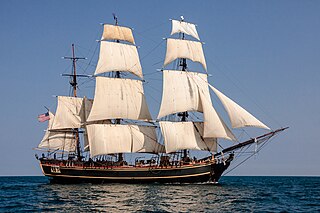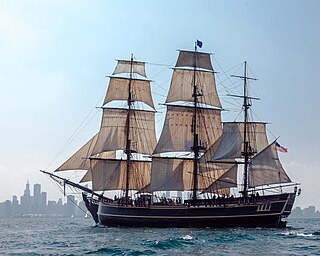Related Research Articles

Vice-Admiral William Bligh was a British officer in the Royal Navy and a colonial administrator. He is best known for the mutiny on HMS Bounty, which occurred in 1789 when the ship was under his command. After being set adrift in Bounty's launch by the mutineers, Bligh and those loyal to him all reached Timor alive, after a journey of 3,618 nautical miles. Bligh's logbooks documenting the mutiny were inscribed on the UNESCO Australian Memory of the World register on 26 February 2021.

The mutiny on the Royal Navy vessel HMS Bounty occurred in the South Pacific Ocean on 28 April 1789. Disaffected crewmen, led by acting-Lieutenant Fletcher Christian, seized control of the ship from their captain, Lieutenant William Bligh, and set him and eighteen loyalists adrift in the ship's open launch. The mutineers variously settled on Tahiti or on Pitcairn Island. Bligh navigated more than 3,500 nautical miles in the launch to reach safety and began the process of bringing the mutineers to justice.

Fletcher Christian was an English sailor who led the mutiny on the Bounty in 1789, during which he seized command of the Royal Navy vessel HMS Bounty from Lieutenant William Bligh.

HMS Pandora was a 24-gun Porcupine-class sixth-rate post ship of the Royal Navy launched in May 1779. The vessel is best known for its role in hunting down the Bounty mutineers in 1790, which remains one of the best-known stories in the history of seafaring. Pandora was partially successful by capturing 14 of the mutineers, but wrecked on the Great Barrier Reef on the return voyage in 1791. HMS Pandora is considered to be one of the most significant shipwrecks in the Southern Hemisphere.

The Arctic Corsair(H320) is a deep-sea trawler, built in 1960, that was converted to a museum ship in 1999. She is temporarily berthed at Alexandra Dock in Kingston upon Hull, England, pending completion of a new permanent location in the city's Museums Quarter. Exhibits and guides aboard the boat tell the story of Hull's deep-sea fishing industry.

The Spurn Lightship is a lightvessel, previously anchored in Hull Marina in the British city of Kingston upon Hull, England. It was relocated to a shipyard in October 2021 for restoration, prior to becoming a display together with the Arctic Corsair.

Blaydes House is a grade II* listed Georgian house in High Street, Kingston upon Hull, England. Built in the 18th century for the Blaydes family, it is now owned by the University of Hull's Maritime Historical Studies Centre.
The Mermaid-class frigates were a group of six 28-gun sailing frigates of the sixth rate designed in 1760 by Sir Thomas Slade, based on the scaled-down lines of HMS Aurora.
HMS Tweed was a 32-gun sailing frigate of the fifth rate produced for the Royal Navy. She was designed in 1757 by Sir Thomas Slade, based on the lines of the smaller sixth rate HMS Tartar, but with a 10-foot midsection inserted. She was built in Blaydes Yard in Kingston-Upon-Hull.
HMS Tavistock was a 50-gun fourth rate ship of the line of the Royal Navy.

HMS Bounty, also known as HM Armed Vessel Bounty, was a British merchant ship that the Royal Navy purchased in 1787 for a botanical mission. The ship was sent to the South Pacific Ocean under the command of William Bligh to acquire breadfruit plants and transport them to the British West Indies to provide a cheap food source for the West Indies' large enslaved population. That mission was never completed owing to a 1789 mutiny led by acting lieutenant Fletcher Christian, an incident now popularly known as the Mutiny on the Bounty. The mutineers later burned Bounty while she was moored at Pitcairn Island in the Southern Pacific Ocean in 1790. An American adventurer helped land several remains of Bounty in 1957.

Bounty was an enlarged reconstruction of the original 1787 Royal Navy sailing ship HMS Bounty, built in Lunenburg, Nova Scotia, in 1960. She sank off the coast of North Carolina during Hurricane Sandy on October 29, 2012.

HMS Mermaid was a Mermaid-class sixth-rate frigate of the Royal Navy. She was first commissioned in April 1761 under Captain George Watson and built in Blaydes Yard in Kingston-Upon-Hull.
HMS Boreas was a modified Mermaid-class sixth-rate frigate of the Royal Navy. She was first commissioned in August 1775 under Captain Charles Thompson. She was built at Blaydes Yard in Hull to a design by Sir Thomas Slade at a cost of £10,000. She was fitted out at Chatham Docks.
The Temple class ships were two 68-gun third rates designed for the Royal Navy to the lines of the Vanguard of 1748, i.e. to the outdated 1745 Establishment. The Temple class ships were the last 68-gun ships to be built - both by commercial contract - to the draught specified by the 1745 Establishment.

HMS Scarborough was a 20-gun ship built in 1756 which served the Royal Navy until 1780. She had a crew of 160 men.

HMS Success was a 20-gun Royal Navy ship launched in 1740 as the first government contract for the Blaydes Yard in Hull. She had a crew of 140 men. She had several famous commanders over her lifetime.
References
- ↑ "Mutiny on the Bounty: the Story of the Bethia from Blaydes Yard". farhorizons.hull.ac.uk. Retrieved 11 March 2021.
- 1 2 "Hugh Blaydes (1686-?)". threedecks.org. Retrieved 11 March 2021.
- 1 2 "Blaydes House • History Around Hull • MyLearning". www.mylearning.org. Retrieved 11 March 2021.
- ↑ "Agreement between Hugh Blaydes of Ranby Hall and Jonathan Such, father and son of Paull brickmakers". 25 June 1825. Retrieved 11 March 2021– via National Archive of the UK.
- ↑ "The Arctic Corsair". Maritime Hull. 11 March 2021. Retrieved 11 March 2021.